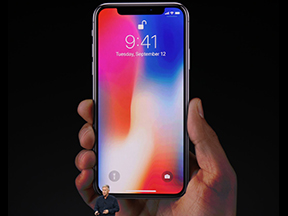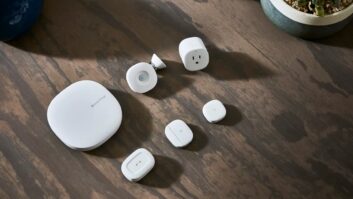
Apple’s new iPhone X will undoubtedly be one of the most fully featured phones on the market, but its role as the new brain of Apple’s smart-home vision is what makes it even more compelling for consumers and retailers.
Apple’s HomeKit is the heart of that vision, and the company’s forthcoming iOS 11 will increase the universe of HomeKit peripherals by enabling third-party devices to become HomeKit compatible with just a firmware update. Once a manufacturer pushes an update to the device, the Apple Home App will find it, enabling the device to be controlled by the iPhone X.
Looking ahead, Apple’s forthcoming HomePod smart speaker, due in December, will hit a consumer market that already understands how voice control can change their lives and may be looking for the next generation to replace their Amazon Echoes and Google Homes. If they already live in an Apple household with multiple iPhones, iPads and MacBooks, they are more likely to look at the HomePad as the next logical step up. Apple is betting $350 a pop that is the case.
Most likely, if a customer is already spending $1,000 on an iPhone X, it’s doubtful that a $350 smart speaker would be out of the question. And early adopters of smart thermostats and lights, simple systems controlled by Alexa or Google Assistant, will be assured that their current peripherals will work with Siri.
See also: HomePod Could Be The Smart Home’s Rising Tide
Looking further afield, Apple’s Face ID technology has the potential to additionally simplify smart-home control, with upgrades that may include gesture commands, or ITTT chains of commands that can activate a series of systems — say music, lighting, climate control — with a glance at the phone screen.
Another feature of iOS 11 is a more feature-rich Apple Music app that will simplify multiroom audio by allowing third-party HomeKit-compatible smart speakers to be chained to a HomePod, and controlled by Siri voice commands. The new Apple Music will also expand its social element and allow users to share playlists and comments to friends who are also using the app.
Cynically, one can point to Apple competitors and make a compelling argument that Apple’s ecosystem is overkill, or doesn’t measure up. Amazon’s and Google’s flagship home hubs are priced below $200, and as low as $50 for Amazon’s Dot. The average consumer will likely stick with the system they have, and expand their systems to multiple rooms at a much lower price tag. Assuming most third-party HomeKit speakers will lack onboard Siri, HomePod owners will be limited to voice commands through the HomePod alone, in one room, or spending $350 per room to expand the voice range, or be forced to carry their iPhone with them from room to room.
Apple is also limiting Siri’s capabilities to specific categories. She will tell you the weather or how many ounces in a cup, but she won’t be able to call an Uber or order a Domino’s pizza like Alexa and Google Assistant. (Note to Google: Please change that name.) But you can do those things on the iPhone, and Apple seems to be banking on the fact that its users are never far from their phones.
What we have learned over the years is that Apple people remain Apple people, and there will undoubtedly be tons of Apple users who take the next step from just upgrading their iPhone every year to buying into a HomeKit hub that unites all their other Apple devices in a more seamless way. Apple’s price tags over the years have failed to suppress demand for their products. That will not likely change with the new iPhones or the coming SmartHub.












